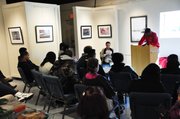Three years ago, Elise Ashby Arrington decided that she wanted her son Harrison Craddock to understand the importance of Black History Month. So she had Craddock, a track and football player at Herndon High School, connect with a few of his fellow athletes at Herndon and nearby high schools.
“There’s a lot of black history that kids these days aren’t aware of, so I wanted to do something to educate them, and anyone else that was interested,” Arrington said. “When we first moved here, he mentioned that there weren’t any local Black History Month events to go to, so I decided to create one.
“Since my son knows a lot of athletes, I figured he could get them involved.”
The first year they presented a slideshow featuring works of noted painter Jacob Lawrence, the year after that they highlighted the contributions of African-Americans to the city of Washington, D.C.
This year the students read selections from important documents leading up to the Emancipation Proclamation, which was signed 150 years ago on Jan. 1, 1863.
They started with the Fugitive Slave Act of 1850, which mandated the return of any escaped slaves to their masters, and it made it the duty of any law enforcement officer to apprehend the escaped slaves.
“The Fugitive Slave Act was one of those most controversial acts of the 1850 compromise [between Northern and Southern states], and it heightened the fears of a slave power conspiracy,” said Cameron Reynolds, a senior football, basketball and track player for Stone Bridge High School. “Abolitionists nicknamed it the ‘Bloodhound Law’ for the dogs that were used to track down runaway slaves.”
From that act in 1850, the students traced several documents all the way through the passage of Abraham Lincoln’s proclamation that freed the slaves, to the 13th amendment (which abolished slavery), 15th amendment (which prohibits voting discrimination on the basis of race) and 19th amendment (which gave women the right to vote).
In addition to Craddock and Reynolds, Herndon students Casey Holland, Will Ferguson, Darrius Hicks, Austin Schnarrs, Ryan Griffin and Denzel Weaver also participated in the event. They were joined by Justin Walker, a senior at Cedar Lane High School, Malik Piersol, a junior at Westfield High School and Dawton Robinson, a senior at Quander Road High School.
Several members of the group went to see the document on display at the National Archives in Washington, D.C. on Jan. 1.
“We waited in line for more than an hour waiting to go see the document, and it was pretty cold,” Craddock said. “But it was worth it.”

